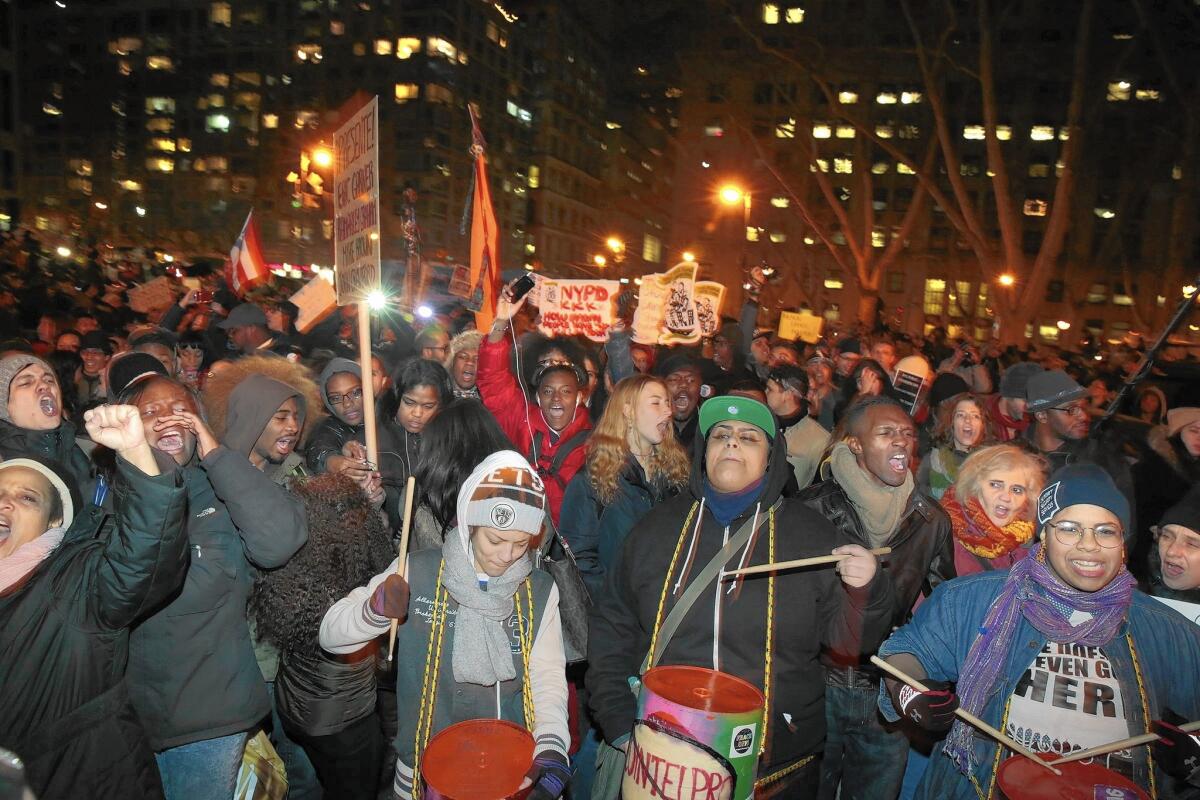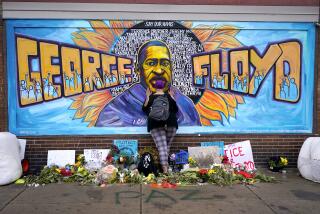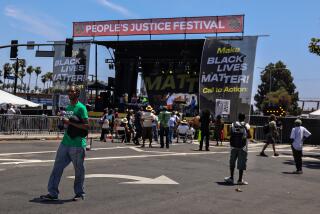Police killings prompt activists to seek ‘new civil rights movement’

- Share via
REPORTING FROM NEW YORK — The chants are angry, but simple: “I can’t breathe!” “Hands up, don’t shoot!” “Black lives matter!” They have echoed from the American heartland to the coasts in the wake of two recent grand jury decisions that cleared white policemen in the deaths of unarmed black men.
Now, activists are counting on the rage behind those words to spur a movement that would force the country to confront the interlocked issues of race and policing and press the government to automatically take control of cases of alleged police abuse.
“They’re asking for something simple. They want to be treated the same,” New York Mayor Bill de Blasio said of protesters Thursday as he sought to calm a city where many were seething over a grand jury’s decision not to indict Daniel Pantaleo, a white officer, in the death of Eric Garner.
Largely peaceful demonstrations broke out in New York soon after Wednesday’s announcement of the Staten Island grand jury’s decision. Protesters blocked major roads and gathered at landmark sites, including Times Square and Grand Central Terminal. Police made 83 arrests, mainly for minor offenses.
More large demonstrations erupted Thursday night in New York and throughout the nation, including in Boston, Washington, Pittsburgh and Chicago. As night fell in New York, helicopters thundered over lower Manhattan while protesters gathered in Foley Square, near the courthouse and police headquarters.
“It was a murder on video and there was no justice,” said Mickey Thomas, a 21-year-old Hunter College student. “I definitely think we’ve had enough. I feel like there is a new civil rights movement.”
Ida Dupont, a Pace University sociology professor specializing in criminology, said she too thought the Garner incident was an “open and shut case” with the video.
“It was so ridiculous to me that I had to be here today to show my outrage,” Dupont said.
“I’ve been talking to my students about it,” she said. “All the young people know something is seriously wrong.”
Last week, violence, arson and looting erupted in Ferguson, Mo., after a grand jury declined to indict Darren Wilson, a white policeman, in the shooting death of Michael Brown. Marches have been almost daily occurrences there since Brown’s shooting in August
At a Thursday news conference, black leaders, including Al Sharpton of the National Action Network and Marc Morial, president of the National Urban League, sought to draw protesters from around the country to Washington for a Dec. 13 event aimed at pressing for federal intervention in excessive-force cases.
“Marches and boycotts led to the ’64 Civil Rights Act,” Sharpton noted. He said that just as federal legislation led to change 50 years ago, similar action is needed now to ensure that prosecutors no longer handle cases involving their own police. “That’s what [Dec.] 13th is all about,” Sharpton said.
Marches in Washington in recent years have done little more than draw a few thousand people voicing concern over issues including fracking and veterans care.
This time, however, those pushing for change have the attention of some of the nation’s top leaders, who view their demands through personal eyes — from President Obama and Atty. Gen. Eric H. Holder Jr. to De Blasio, whose wife is black.
The New York mayor spoke emotionally this week of the concerns he and his wife had for their 17-year-old son, Dante, in his dealings with police. “I couldn’t help but immediately think of what it would mean to me to lose Dante,” De Blasio said. “Life could never be the same.”
Holder has launched federal inquiries into several police departments in recent years, and many have led the Justice Department to mandate reforms. But those investigations often follow years of abuse claims, and they are never guaranteed to take place. The demand made Thursday was to automatically put in federal hands cases in which law enforcement officials face possible criminal charges arising from civilian deaths or injuries.
The visceral impact of Garner’s death, which was captured on video, and the recent death of Tamir Rice, a black 12-year-old shot dead by Cleveland police in an incident also caught on video, could help galvanize protesters, experts said.
Connie Rice, a civil rights attorney and founder of the Advancement Project in Los Angeles, said that if the mainly young marchers taking part in current protests harness those demonstrations into political action, “we’ll see a response that’s more than lip service.”
“It’s a continuation of a very old civil rights era,” Rice said of the latest cries for change. “It’s not going to look like it did, but that doesn’t mean it’s new.”
One question is whether the current anger will do what the Occupy movement failed to do: bring actual change at the top. Sharpton, without mentioning Occupy by name, appeared to allude to the movement when he spoke of the scattered protests across the country.
“We need to centralize,” Sharpton said, an approach that was contrary to Occupy’s determination to avoid getting tied down by specific demands. “The luxury that some have is to just express outrage. Those of us who have the connections to actual victims — we have to sit with them and say how this will achieve justice.”
Darnell Hunt, a media and race expert at UCLA, said only time would tell whether Sharpton’s goals come to fruition. “But there does seem to be something very palpable in terms of a rising awareness around questions of race and fairness,” Hunt said.
The New York Police Department said Thursday it was moving forward with an internal review of officer Pantaleo’s actions on the day Garner died.
Pantaleo and the police officers union have denied that he used a banned chokehold on Garner, who died as police tried to arrest him on allegations of selling illegal cigarettes. Pantaleo will face an administrative trial, which could bring a range of punishments, including his termination from the NYPD, said Lt. Col. John Grimpel, a department spokesman.
There were fresh frustrations in New York over details of the grand jury proceedings. By law, documents are sealed unless prosecutors request public release.
In St. Louis County, prosecutor Bob McCulloch released thousands of pages of documents as soon as the grand jury returned its decision in the Darren Wilson case.
But the district attorney in Staten Island, Daniel Donovan, asked a judge to release only a limited amount of information from the New York grand jury case. The material did not include any transcripts from the 50 witnesses, including Pantaleo, who testified during the nine weeks the grand jury met.
The grand jury needed 12 votes to indict Pantaleo. It is not known whether anyone among the jurors favored an indictment.
In a brief statement, Donovan did not explain why he only sought a limited release of information. Among the details made public: the witnesses included 22 civilians, in addition to police officers, emergency personnel, and doctors; 60 exhibits were entered into evidence, including autopsy photographs and records of NYPD policies and procedures. That indicated jurors studied the restraint tactics used by the department, which bans chokeholds but permits other take-down techniques.
In the Tompkinsville section of Staten Island, on the sidewalk where Garner died, a makeshift memorial of cards, flowers and candles grew as people stopped by to add to the items or just take in the sight. One of the visitors Thursday was Gwen Carr, Garner’s mother, who urged the protesters to harness their anger into an effective, but peaceful, movement for change. Sharpton said Carr would be among those taking part in the march in Washington.
“It’s amazing,” Carr said of the protests surrounding her son’s death. “Keep it up.”
Maya Srikrishnan contributed to this report from New York. Trevell Anderson, Michael Muskal and James Queally contributed from Los Angeles.
More to Read
Sign up for Essential California
The most important California stories and recommendations in your inbox every morning.
You may occasionally receive promotional content from the Los Angeles Times.











